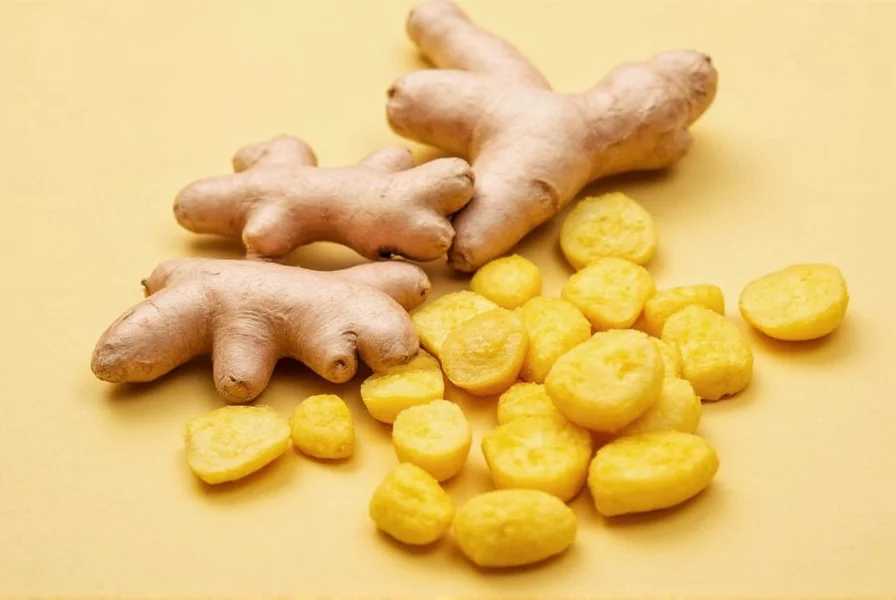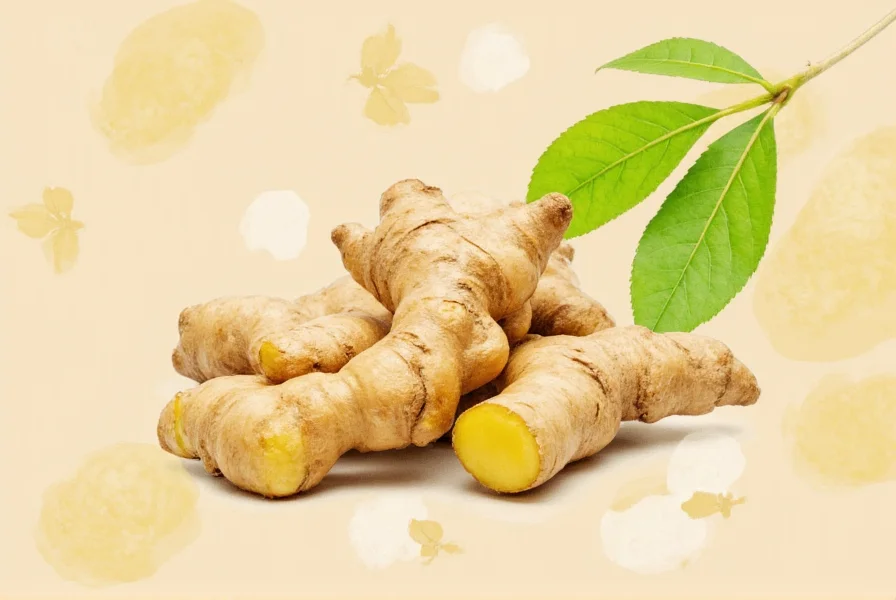Understanding the unique properties of young ginger helps home cooks and professional chefs make informed decisions when selecting ingredients for specific culinary applications. Unlike its mature counterpart, young ginger's delicate texture and subtle flavor profile offer distinct advantages in certain recipes and preparations.
What Exactly Is Young Ginger?
Young ginger represents the early harvest stage of the ginger plant (Zingiber officinale), typically gathered between 4-6 months after planting, well before the rhizomes reach full maturity at 8-10 months. This early harvest produces rhizomes with distinctive characteristics that set them apart from the more commonly available mature ginger.
The harvesting timeline significantly impacts the ginger's chemical composition. Young ginger contains higher concentrations of zingerone (which provides a sweeter, more delicate flavor) and lower levels of gingerol (responsible for the characteristic heat in mature ginger). This biochemical difference explains why young ginger offers a more subtle, nuanced flavor profile that works exceptionally well in raw preparations.
Young Ginger vs. Mature Ginger: Key Differences
Understanding the distinctions between young and mature ginger helps determine which variety best suits your culinary needs. The differences extend beyond mere appearance to fundamental characteristics affecting flavor, texture, and appropriate usage.
| Characteristic | Young Ginger | Mature Ginger |
|---|---|---|
| Harvest Time | 4-6 months after planting | 8-10 months after planting |
| Skin Thickness | Thin, almost translucent (doesn't require peeling) | Thick, tough, fibrous (usually requires peeling) |
| Moisture Content | High (75-80%) | Lower (60-65%) |
| Flavor Profile | Milder, sweeter, more citrusy notes | Stronger, spicier, more pungent |
| Gingerol Content | Lower concentration | Higher concentration |
| Texture | Tender, almost succulent | Firmer, more fibrous |
| Storage Life | Shorter (1-2 weeks refrigerated) | Longer (3-4 weeks refrigerated) |
Nutritional Profile and Health Benefits
While both young and mature ginger share many nutritional properties, the immature variety offers some unique benefits due to its different chemical composition. Young ginger contains higher levels of certain volatile compounds that contribute to its distinctive flavor and potential health benefits.
Research published in the Journal of Agricultural and Food Chemistry indicates that young ginger contains elevated levels of certain antioxidants compared to mature ginger, particularly during its early growth stages. The lower gingerol content makes it gentler on the digestive system while still providing anti-inflammatory benefits.
Nutritionally, a 1-inch piece of young ginger (approximately 15g) typically contains:
- Calories: 5-7
- Carbohydrates: 1.3g
- Fiber: 0.2g
- Vitamin C: 1.3mg (2% of daily value)
- Magnesium: 4.5mg (1% of daily value)
- Potassium: 30mg (1% of daily value)
Culinary Applications of Young Ginger
The unique properties of young ginger make it particularly valuable in specific culinary contexts where the stronger flavor of mature ginger would overpower other ingredients.
Chef Mei Lin, winner of Top Chef season 12, explains: "Young ginger's delicate flavor works beautifully in raw preparations where you want ginger notes without the aggressive heat. It's perfect for dressings, marinades, and dishes where subtlety matters."
Popular culinary uses include:
- Japanese cuisine: Used in gari (pickled ginger served with sushi) because its tender texture absorbs vinegar beautifully
- Thai cooking: Essential in certain curry pastes where a milder ginger flavor is desired
- Raw applications: Can be thinly sliced or julienned for salads without needing peeling
- Pickling: Ideal for quick pickles due to its high moisture content and tender texture
- Beverages: Creates smoother ginger teas and cocktails without excessive heat

Selecting and Storing Young Ginger
When shopping for young ginger, look for these characteristics to ensure you're getting the genuine article:
- Appearance: Smooth, almost translucent skin that's pale yellow or light beige (not brown)
- Texture: Firm but yielding slightly to gentle pressure (shouldn't feel woody)
- Moisture: Should feel heavy for its size, indicating high water content
- Smell: Fresh, clean aroma with citrus notes rather than intense spiciness
Proper storage extends young ginger's relatively short shelf life:
- Refrigerate in a paper towel inside a perforated plastic bag
- Do not wash before storing (excess moisture accelerates spoilage)
- Use within 1-2 weeks for optimal freshness
- For longer storage, slice and freeze in an airtight container (up to 3 months)
Seasonality and Availability
Young ginger has a limited seasonal availability that varies by growing region:
- Asia: Primarily available March-June (harvested before the monsoon season)
- North America: Most abundant May-August (depending on local growing conditions)
- Australia: Available November-February
During off-season months, specialty Asian markets, farmers' markets, and premium grocery stores may still carry young ginger, though it often commands a higher price (typically 2-3 times more than mature ginger). Some online specialty food retailers now offer seasonal young ginger shipments directly from growers.

Substitution Guidelines
When young ginger isn't available, proper substitution requires understanding the flavor and texture differences:
- For raw applications: Use ½ the amount of mature ginger and remove fibrous strands
- For cooked dishes: Substitute equal amounts but expect more pronounced heat
- For pickling: Mature ginger requires longer soaking to achieve similar tenderness
- For beverages: Add mature ginger later in the process to control heat extraction
Professional chefs sometimes recommend blending mature ginger with a small amount of lemon zest to approximate young ginger's citrus notes in recipes where the authentic ingredient isn't available.
Frequently Asked Questions
Can you eat the skin of young ginger?
Yes, the skin of young ginger is exceptionally thin and tender, making it completely edible without peeling. This contrasts with mature ginger, which has thick, fibrous skin that typically requires removal before use. The edible skin makes young ginger particularly convenient for quick preparations like grating into dressings or thinly slicing for salads.
Why is young ginger more expensive than regular ginger?
Young ginger commands a higher price due to several factors: it's harvested earlier in the growing cycle (reducing overall yield per plant), has a much shorter shelf life requiring faster distribution, is only available seasonally, and requires more careful handling due to its delicate nature. The labor-intensive harvesting process for young ginger, which often happens by hand to avoid damaging the tender rhizomes, also contributes to the higher cost.
Does young ginger have the same health benefits as mature ginger?
While both varieties share many health benefits, there are some differences. Young ginger contains lower levels of gingerol (the compound responsible for ginger's heat and many therapeutic properties) but higher levels of certain antioxidants and zingerone. It offers similar anti-inflammatory and digestive benefits but in a milder form, making it gentler for those with sensitive stomachs. The nutritional profile varies slightly due to the different growth stages, but both contribute valuable compounds to a healthy diet.
How can I tell if I've purchased genuine young ginger?
Authentic young ginger has several distinguishing features: very thin, almost translucent skin that's pale yellow or light beige (not brown), high moisture content making it feel heavy for its size, tender texture that yields slightly to gentle pressure (not woody), and a fresh, clean aroma with citrus notes rather than intense spiciness. If the ginger requires peeling or has a strong burning sensation when tasted raw, it's likely mature ginger being marketed as young ginger.











 浙公网安备
33010002000092号
浙公网安备
33010002000092号 浙B2-20120091-4
浙B2-20120091-4